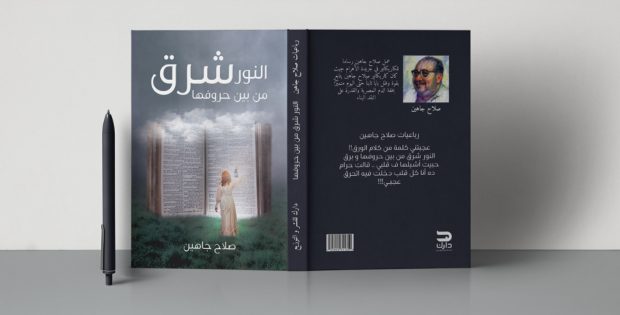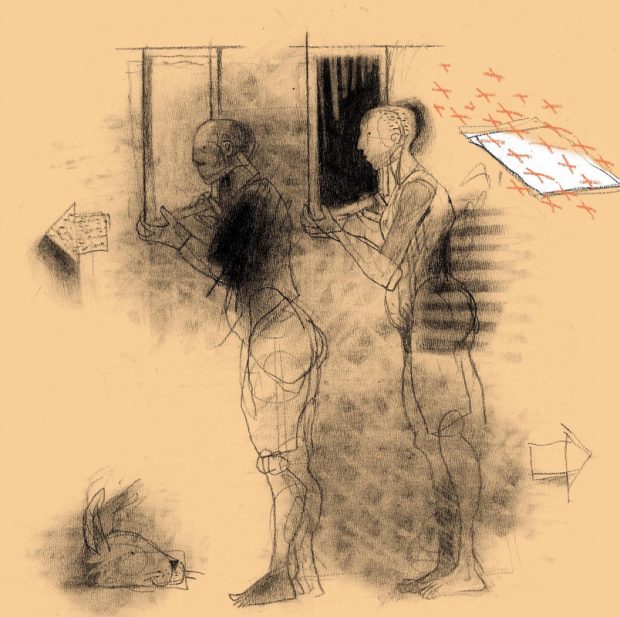콰르텟으로 ‘인간’을 노래한 이집트 시인 살라 야힌
*아시아엔 해외필진 기고문의 한글번역본과 원문을 함께 게재합니다.
콰르텟(4중주)은 4개의 주제로 문제의 근본에 접근하는 서양철학을 의미한다. 페르시아의 시인이자 철학자이자 우마르 하이얌(Omar Khayyam)의 책을 읽은 이들은 공감할 수 있을 것이다. 콰르텟의 또다른 형태를 제시한 이집트의 시인이자 철학가 살라 야힌(Salah Jahin)을 소개한다.
살라 야힌은 1930년 이집트 카이로 중산층 가정에서 태어났다. 카이로 대학에서 법학을 공부한 그는 1955년 이집트 주간지 ‘로즈 알 유세프’에서 만평가로 활동을 시작했다. 1년 후 막 창간한 잡지 ‘사바 엘 카이르’에서 편집장을 역임했으며, 그 후 이집트의 전통매체 ‘알 아람’으로 자리를 옮겨 오랜 기간 만평을 연재했다.
야힌이란 이름은 1960년 어린이 인형극 오페라 ‘엘 라일라 엘 케비라’(El-Laila El-Kebira, The Big Night)에서 유래했다. 이 작품은 살라 엘 사카(Salah El-Saqqa)가 연출했고, (Sayed Mekawy)가 곡을 썼다.
다방면에서 활동해 왔던 야힌은 가수들은 물론 책표지를 디자인하는 젊은 예술가들에게도 큰 영감을 선사했다.
시인이자 만평가, 작곡가, 각본가이기도 한 야힌은 1963년 이집트 주간지 굿모닝에 출판된 콰르텟을 모아 한 권의 책으로 펴냈다. 그는 순간, 순간들을 시간순으로 전하는 대신 특별한 순간들을 전했다. 한 시간 안에 읽을 수 있는 한 권의 책에 불과하지만, 저자는 삶의 굴곡을 통해 느꼈던 감정을 독자들과 공유하길 바랐다.
이 책의 1장에서 그는 삶의 대한 강한 욕구와 삶의 위대함을 표현한다. 그는 삶에 대한 애착을 드러내면서 역설적으로 현생에 대한 경멸 또한 말한다. 관능적인 쾌락 혹은 영적인 쾌락의 경계선에서. 그는 낙관론자인가 비관론자인가? 아니면 종교적 믿음이 불충한 이교도인가?
“나는 불가능한 것에 호기심이 생긴다 / 나는 달을 보고 하늘 높이 뛰어오른다 / 달을 잡든 말든 상관없다 / 내 마음은 이미 기쁨으로 가득 차 있다”
위 문장은 이집트 구어체에 새로운 단어와 표현을 더 한 것으로, 대중적으로도 센세이션을 일으킨 야힌의 철학을 잘 나타낸다.
야힌은 가말 압델 나세르(Gamal Abdel Nasser) 정권 때 아랍의 민족주의를 고취시킨 애국적인 노랫말을 지은 것으로도 잘 알려져 있다. 서구에 대항해 아랍의 민족주의를 고취시킨 이른바 ‘나세르주의’를 대표하는 시인 중 하나다. 그러나 야힌은 1967년 이집트의 전쟁패배와 1970년 나세르의 죽음, 그의 갑작스러운 정치적 전향 이후 모진 풍파를 겪었다.
야힌의 시 구절은 인간 삶의 목적, 선과 악의 본질, 인간과 신의 의지, 자유와 행복을 추구하는 인간의 한계를 노래한다. 추상적이고 난해하지만, 그만의 철학이 담겨 있는 것은 분명하다. 야힌은 1986년 4월 21일 길지 않은 생을 마감했다.
야힌의 콰르텟을 집대성한 책이 출판된 지 어느덧 60여년이 흘렀다. 최근 이집트에선 야힌의 콰르텟을 새롭게 해석한 시리아 예술가 유세프 압델케의 전시회가 주목받고 있다.
“거대한 피의 강에서 허우적대는 시리아 국민의 감정을 표현하고자 했다.” 압델케는 초현실적인 목탄화를 통해 내전으로 고통받고 있는 모국의 아픔을 표현했다. 정성스럽게 그려진 정물화 위엔 붉은 자국이 묻어 있으며 두개골, 뼈, 못에 박힌 심장과 같은 노골적인 상징들도 그려져 있다.
1981년부터 2005년까지 프랑스 파리에서 거주했던 압델케는 ‘파리 국립고등미술학교’(?cole Nationale Sup?rieure des Beaux-Art)에서 수학했다. 그러나 그의 활동이 달갑지 않던 이들에 의해여권이 몰수되고 또 체포 당하며, 압델케는 짧지 않은 공백기를 가지게 됐다
오랜 침묵을 깬 그의 복귀작에선 2015년부터 2019년까지 제작한 작품들이 전시된다. 살라 야힌의 콰르텟 중 35개의 주제를 중점적으로 다뤘으며, 또한 마르셀 뒤샹, 마흐무드 무크타르, 호쿠사이, 마흐무드 사이드, 셰이크 이맘 등 당대의 아티스트에게 헌정하는 작품들을 준비했다.
Jahin’s Egyptian Quartets: Life after Death!
Ashraf Aboul-Yazid (Ashraf Dali)
The quartets are the best form for the philosophical poet who wants to present his doctrine to us, not in a jurisprudential study or in a logical sequence, but in bright flashes. This is known by Omar Khayyam readers all over the world, but in Egypt, there has been another poet, another philosophy and definitely another book of quartets.
In 1963, Salah Jahin; a poet, political cartoonist, songwriter, scriptwriter and children theater creator, collected his published quartets in the Egyptian weekly Magazine (Good Morning), to be printed in one volume, to shape a cultural taste with its depths.
The book is a mirror of the poet’s life, but it does not present you with its days in sequence, but rather chooses from them its unique moments. You may read it in an hour, but you feel that you have lived with the poet throughout his long emotional life,.
Quartet one foretells of a strong appetite for life and its greatness. And attached to it, and at the same time foretells the disdain for this life and its contempt. You do not know whether it is a sensual pleasure or is it a spiritual pleasure? Am I an optimist or a pessimist believer? Is he an infidel?
Jahin writes: “I am the one intrigued by the impossible/ I see the moon and jump high into the sky/ Whether I catch it or not should not matter/ As my heart is already filled with joy.”
This famous quartet summarizes the philosophy of Salah Jahin, that revolutionized popular songwriting with his unique phrasings, adding charming new words and delightful expressions to the colloquial Egyptian vocabulary.
The famous name of Jahin has also built upon the 1960 children puppets operetta “El-Laila El-Kebira (The Big Night), directed by Salah El-Saqqa, and tuned by music composer Sayed Mekkawy.
In addition, the daily political and social cartoons by Salah Jahin, published for long years in Al-Ahram newspaper, gave another deep dimension of the poet’s thought.
This week, after six decades, the quartets have been come alive, again, as Syrian artist Youssef Abdelke is showing his reflections on them, in Cairo>
Abdelke’s hyper -realistic charcoal works on paper evoke a nation at war as they attempt to “express the concerns and emotions of the ordinary Syrian citizen amid this huge river of blood,” says the artist, referring to his native country’s recent history. His carefully rendered still lifes are splattered with red paint and often include overt memento mori such as skulls, bones, and even a heart impaled on a nail.
Abdelke lived in Paris from 1981 through 2005 and attended the ?cole Nationale Sup?rieure des Beaux-Arts. However, he was later forbidden from leaving Syria after his passport was confiscated and he was arrested for his activism.
?After a long absence from the Egyptian scene, the well-known Syrian Artist Youssef Abdelk? comes back with a new exhibition. It includes 35 subjects coming from Salah Jahin’s quartets, that the Egyptian poet wrote between 1959 and 1962.
After drawing them between 2015 and 2019, eventually Abdelk? made a limited edition of 10 copies numbered and signed, including hommages to some famous artists like Marcel Duchamps, Mahmoud Mokhtar, Hokusai, Mahmoud Said and Sheikh Imam.
The quartets of Jahin have been inspiring many singers to present them for his fans, but they were also a solid material to inspire young artists who designed cover books with selections of these quartets.
“And the spring came, laughing at my sad fate
It called my name, I inquired: who
Spring put its flowers beside me and gone
What do flowers do for the dead?
I wonder..”
Jaheen was born in Cairo, 1930 to a middle-class family. He studied law in Cairo University. In 1955, he started working for the Egyptian weekly magazine “Rose al-Yousef” as a cartoonist. A year later, he moved to the new magazine “Sabah el-Khair (Good Morning)” for which he became its editor-in-chief. Then he joined Al-Ahram newspaper.
He was known for his nationalist and patriotic songs that marked the revolutionary era of Gamal Abdel Nasser role and was sometimes known as the semiofficial poet of the revolution. However, after Egypt’s defeat in the 1967 war and Nasser’s death in 1970 and the sudden shift in political orientation he felt increasingly like Hamlet with the following President Sadat, embodying the treacherous Claudius.
Jahin’s poems frequently contain abstract metaphysical and philosophical themes questioning the purpose of human life, the nature of good and evil, human and divine will and the limits of human pursuit of freedom and happiness. He passed away in April, 21, 1986.








잘읽었습나다 . 한구어로 번역이 되어도 좋을 것 같습니다